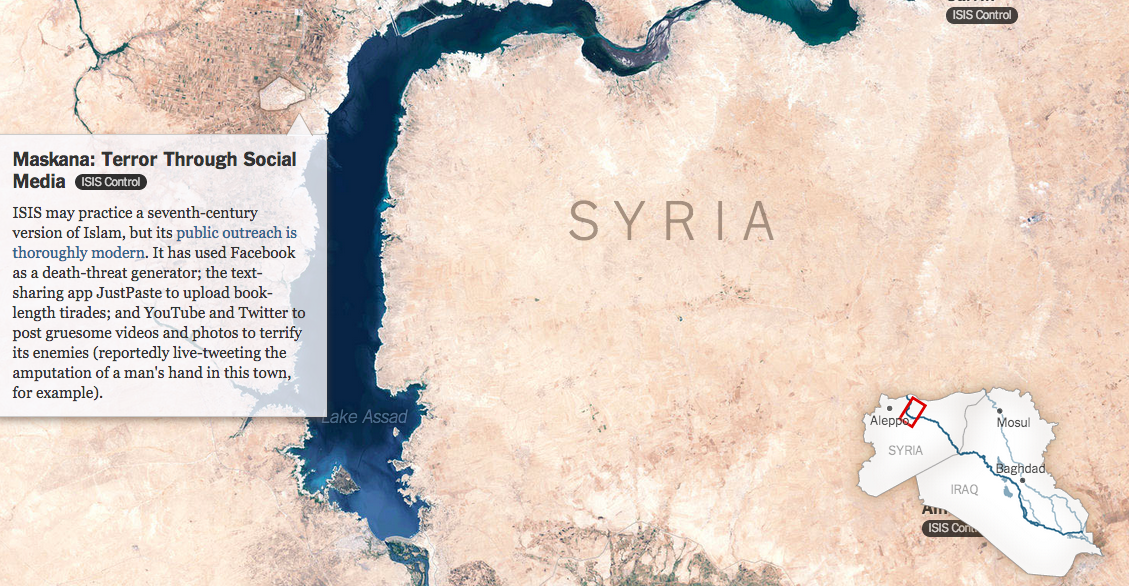World History
 On Wednesday my county had its in-service day and one of the themes we discussed was connecting material we are teaching to today's world. Well for those of you who teach ancient world history, this NYTimes article will make it easy as it both has an article as well as a great graphic showing what ISIS (Islamic State in Syria and Iraq) has captured along the Tigris and Euphrates Rivers and also has Aleppo on the map. The article also mentions a number of Americans joining the terrorist group. Talk about making it relevant!
On Wednesday my county had its in-service day and one of the themes we discussed was connecting material we are teaching to today's world. Well for those of you who teach ancient world history, this NYTimes article will make it easy as it both has an article as well as a great graphic showing what ISIS (Islamic State in Syria and Iraq) has captured along the Tigris and Euphrates Rivers and also has Aleppo on the map. The article also mentions a number of Americans joining the terrorist group. Talk about making it relevant!
- Looking At 4,000 Year Old Dna From Greenland
There is an interesting find at of Greenland. The DNA of a 4,000 year old man was sequenced and some surprises were discovered. An article titled After 4,000 years, DNA suggests ancient Greenland man had risk of baldness and even dry earwax was written...
- Remind Your Students Using Texts
Today I found an article on the Washington Post that goes with along with what some of my students are doing for homework. So, today I sent them the link to the article and was able to do it because all of my students voluntarily sign up for Remind.com because...
- Iraq, Wwi And The Ongoing Problems Today
George Coe and I are clearly thinking along the same lines as this is a fantastic article from the NYTimes on how the Ottoman Empire and WWI is still impacting Iraq's problems today. The video above explains the three groups (Sunnis, Shi'ites...
- Motivating Your World History Students
I have a great group of freshmen this year, but I always have students who do not understand the importance of education. Since this is a world history class, you might want to show the first few minutes of this film to your students (although you...
- Demotic - Language Of Everyday Egyptians
As teachers, I believe, we teach a very neat history in our class. Our textbooks have made history very neat, almost, in some cases, different than what the every day people of the time would remember. I like to ask my students why, and how...
World History
ISIS and the Tigris and Euphrates

- Looking At 4,000 Year Old Dna From Greenland
There is an interesting find at of Greenland. The DNA of a 4,000 year old man was sequenced and some surprises were discovered. An article titled After 4,000 years, DNA suggests ancient Greenland man had risk of baldness and even dry earwax was written...
- Remind Your Students Using Texts
Today I found an article on the Washington Post that goes with along with what some of my students are doing for homework. So, today I sent them the link to the article and was able to do it because all of my students voluntarily sign up for Remind.com because...
- Iraq, Wwi And The Ongoing Problems Today
George Coe and I are clearly thinking along the same lines as this is a fantastic article from the NYTimes on how the Ottoman Empire and WWI is still impacting Iraq's problems today. The video above explains the three groups (Sunnis, Shi'ites...
- Motivating Your World History Students
I have a great group of freshmen this year, but I always have students who do not understand the importance of education. Since this is a world history class, you might want to show the first few minutes of this film to your students (although you...
- Demotic - Language Of Everyday Egyptians
As teachers, I believe, we teach a very neat history in our class. Our textbooks have made history very neat, almost, in some cases, different than what the every day people of the time would remember. I like to ask my students why, and how...
